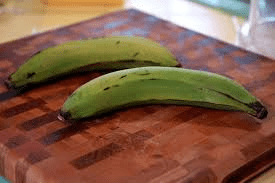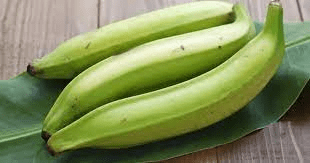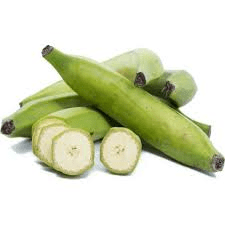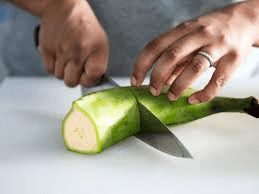Plantain Skin is the outermost layer of the fruit known as plantain, botanically classified as Musa paradisiaca. This skin serves as a protective barrier, shielding the soft, edible interior of the plantain from environmental factors such as microbes, physical damage, and dehydration. Composed primarily of plant tissue, it features a tough and fibrous texture that varies in thickness depending on the maturity of the fruit.
Initially green when the fruit is unripe, Plantain Skin gradually transitions to yellow and eventually darkens to brown or black as the fruit ripens. This color change is due to the breakdown of chlorophyll and the accumulation of pigments such as carotenoids and anthocyanins. Alongside these pigments, the skin contains a complex network of cells that provide structural support and resilience to the fruit.
Underneath the surface, Plantain Skin consists of several layers. The outermost layer, known as the epidermis, is a single layer of tightly packed cells that acts as a waterproof barrier. This layer helps to prevent excessive water loss from the fruit while also protecting it from pathogens and physical damage. Below the epidermis lies the mesophyll, which comprises several cell types including parenchyma cells responsible for storing nutrients and providing structural support.
Plantain Skin also contains specialized structures such as stomata, which are microscopic pores that allow for gas exchange between the plantain fruit and its surroundings. These pores play a crucial role in regulating the internal environment of the fruit by facilitating the uptake of carbon dioxide needed for photosynthesis and the release of oxygen and water vapor produced during this process.
In addition to its structural role, Plantain Skin harbors various bioactive compounds with potential health benefits. Studies have identified antioxidants such as flavonoids and phenolic compounds in plantain peel, which possess anti-inflammatory and antimicrobial properties. These compounds not only contribute to the plant’s natural defense mechanisms but also offer potential applications in medicine and food preservation.
Furthermore, Plantain Skin serves as a source of dietary fiber, which plays a crucial role in digestive health by promoting regular bowel movements and supporting the growth of beneficial gut bacteria. This fiber content increases as the fruit ripens, making ripe plantains a valuable dietary component in regions where they are commonly consumed.
Plantain Skin is a multifaceted structure that goes beyond its protective function to encompass biochemical and dietary significance. Understanding its composition and properties not only enhances our appreciation of this tropical fruit but also highlights its potential applications in fields ranging from nutrition to biomedicine.
As research continues to uncover the intricate details of plantain peel composition and functionality, it underscores the importance of considering the entire fruit, peel included, in both scientific investigations and everyday culinary practices.
The Economic Importance and Uses of Plantain Skin

1. Animal Feed: Plantain skins are used as a nutritious feed for livestock such as cattle, goats, and pigs.
2. Organic Fertilizer: Composting plantain skins enriches soil with organic matter and nutrients, enhancing crop growth.
3. Biogas Production: Plantain skins are processed in anaerobic digesters to produce biogas, a renewable energy source.
4. Cosmetic Industry: Extracts from plantain skins are used in skincare products for their antioxidant and moisturizing properties.
5. Natural Dye: The pigments in plantain skins are used to produce natural dyes for textiles and crafts.
6. Water Purification: Dried plantain skins are used in water filtration systems to remove heavy metals and impurities.
7. Biodegradable Packaging: Plantain skins can be processed into biodegradable packaging materials, reducing plastic waste.
8. Medicinal Uses: In traditional medicine, plantain skins are used to treat wounds, burns, and skin irritations due to their antimicrobial properties.
9. Biochar Production: Plantain skins are converted into biochar through pyrolysis, which improves soil health and sequesters carbon.
10. Enzyme Production: Skins are used to produce enzymes like amylase and cellulase, valuable in various industrial processes.
11. Pectin Extraction: Plantain skins are a source of pectin, a gelling agent used in food production, especially in jams and jellies.
12. Mushroom Cultivation: The skins are used as a substrate in mushroom farming, providing nutrients for fungal growth.
13. Livestock Bedding: Dried and shredded plantain skins are used as bedding material for livestock, providing comfort and absorbing moisture.
14. Food Additive: Powdered plantain skins are used as a fiber-rich additive in baked goods, cereals, and health supplements.
15. Poultry Feed: Processed skins are included in poultry feed to improve diet and egg production.
16. Soap Making: Plantain skin ash is used in soap making for its natural cleansing properties.
17. Plant Growth Promoter: Extracts from plantain skins are used as natural growth promoters for plants, enhancing their development and yield.
18. Bioethanol Production: Plantain skins are fermented to produce bioethanol, an alternative fuel source.
Read Also: List of Cats that Dont Shed and their Unique Features
The Products and By-products That Can Be Derived From Plantain Skin

1. Animal Feed: Dried and ground plantain skins used as nutritious feed for livestock.
2. Organic Fertilizer: Compost made from plantain skins to enhance soil fertility.
3. Biogas: Renewable energy produced from anaerobic digestion of plantain skins.
4. Skincare Products: Creams and lotions made from plantain skin extracts for skin health.
5. Natural Dye: Dye produced from plantain skin pigments for textiles.
6. Water Filters: Dried skins used in water filtration systems to purify water.
7. Biodegradable Packaging: Packaging materials made from processed plantain skins.
8. Wound Dressings: Traditional medicinal use of skins to treat wounds and skin irritations.
9. Biochar: Soil enhancer made by pyrolyzing plantain skins.
10. Industrial Enzymes: Enzymes like amylase and cellulase extracted from plantain skins.
11. Pectin: Gelling agent extracted from plantain skins for use in food products.
12. Mushroom Substrate: Plantain skins used as growth medium for cultivating mushrooms.
13. Livestock Bedding: Bedding material made from dried and shredded plantain skins.
14. Fiber Supplements: Powdered plantain skins used as dietary fiber supplement.
15. Poultry Feed: Processed plantain skins included in poultry diets.
16. Soap: Natural soap made from plantain skin ash.
17. Plant Growth Enhancer: Plantain skin extracts used as growth promoters for crops.
18. Bioethanol: Alternative fuel produced from fermentation of plantain skins.
Read Also: Himalayan Cats (Felis catus) Description and Complete Care Guide
Frequently Asked Questions (FAQ’s) About Plantain Skin

1. What are plantain skins?
Plantain skins refer to the outer layer of the plantain fruit, which is usually discarded after peeling.
2. How are plantain skins used in agriculture?
Plantain skins are used as animal feed, organic fertilizer, and compost to improve soil fertility and support crop growth.
3. Can plantain skins be used in skincare?
Yes, extracts from plantain skins are used in skincare products for their moisturizing and antioxidant properties.
4. What are the benefits of using plantain skins in water purification?
Dried plantain skins can adsorb heavy metals and impurities from water, making them useful in filtration systems.
5. How are plantain skins used in biogas production?
Plantain skins are processed in anaerobic digesters to produce biogas, a renewable energy source used for cooking and heating.
6. Are plantain skins edible?
Plantain skins are not typically eaten due to their tough texture and bitterness compared to the fruit flesh.
7. How do plantain skins contribute to sustainable agriculture?
Plantain skins can be composted, used as organic fertilizer, and contribute to biodegradable packaging, reducing environmental impact.
8. What traditional medicinal uses do plantain skins have?
In traditional medicine, plantain skins are used to treat wounds, burns, and skin irritations due to their antimicrobial properties.
9. Can plantain skins be used in mushroom cultivation?
Yes, plantain skins provide nutrients and moisture as a substrate for growing mushrooms.
10. How are plantain skins processed for use in industrial applications?
Plantain skins can be dried, ground, or extracted to produce materials for food additives, biodegradable products, and pharmaceuticals.
Read Also: What You Should Know About Spider Monkey

